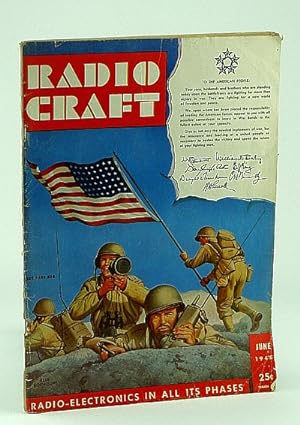BOHR N (28 Ergebnisse)
Produktart
- Alle Produktarten
- Bücher (27)
- Magazine & Zeitschriften (1)
- Comics
- Noten
- Kunst, Grafik & Poster
- Fotografien
- Karten
-
Manuskripte &
Papierantiquitäten
Zustand
- Alle
- Neu
- Antiquarisch/Gebraucht
Einband
Weitere Eigenschaften
Land des Verkäufers
Verkäuferbewertung
-
Quantum d'Action et Noyaux Atomiques
Verlag: Paris, Hermann, 1939
Anbieter: Pallas Books Antiquarian Booksellers, Leiden, Niederlande
paperbound, 8vo 28 pp., IV plates good condition (ex-library).
-
LA THEORIE ATOMIQUE ET LA DESCRIPTION DES PHENOMENES
Anbieter: Librairie Philosophique J. Vrin, Paris, Frankreich
BOHR (N.).La théorie atomique et la description des phénomènes.Quatre articles précédés d'une introduction. Trad. de A. Legros et L. Rosenfeld.P., 1932, in-8°, br., dos cassé, manque à la couverture. 200 gr.
-
ON THE CONSTITUTION OF ATOMS AND MOLECULES
Anbieter: Librairie Philosophique J. Vrin, Paris, Frankreich
BOHR (N.).On the constitution of atoms and molecules.Papers of 1913 reprinted from the Philosophical magazine, with and introduction by L. Rosenfeld.Copenhagen, 1963, in-8° cart. demi-toile édit. ss. jaq., port. et fac-sim. 500 gr.
-
Drei Aufsätze über Spektren und Atombau.
Anbieter: BuchKaffee Vividus e.K., Tuebingen, Deutschland
Buch
Zustand: Gut. Vieweg, Braunschweig 1922 (Slg. Vieweg). VI, 148 S. mit 7 Abb. Umschlag beschäd. Bindung gebrochen, mehrere Lagen lose. ? Der erste Aufsatz erschien 1914 nur in dänisch, die beiden anderen Vorträge auch in der "Zeitschrift für Physik". 83850 / 20004 Mit Ausnahme von Direkt-Recycling Materialien erfolgt der Versand ohne Einsatz von Kunststoffen. Sprache: Deutsch.
-
Ueber den Bau der Atome. [Vortrag bei der Entgegennahme des Nobelpreises in Stockholm am 11. Dezember 1922. Ins Deutsche ubersetzt von W.Pauli Jr.]
Verlag: Berlin 1924, 1924
Anbieter: Antiquariaat Matthys de Jongh, Zutphen, Niederlande
Erstausgabe
. 60p. Orig. printed wrappers, frayed, little damaged at back, names in ink. Bookplate on verso of title. First edition.
-
Collected Works, Vol. 1: Early Work (1905 - 1911).
Verlag: Amsterdam, North-Holland, 1972
Anbieter: Pallas Books Antiquarian Booksellers, Leiden, Niederlande
Cloth, 8vo, gold lettering, gold relief 608 pp., with photograph frontispiece facsimile paper, publications, correspondence; very good condition.
-
Zur Frage der Polarisation der Strahlung in der Quantentheorie.
Verlag: Braunschweig u Berlin Vieweg & Sohn u Springer, 1921
Anbieter: Zentralantiquariat Leipzig GmbH, Leipzig, Deutschland
Verbandsmitglied: BOEV
In: Zeitschrift für Physik Bd. 6, S. 1-9. Lwdbd. m. goldgepr. Rtit. M. Bibl.-Einstecktasche a. hint. Innendeckel. M. mehr. St. Poggendorff V, 139. Erste deutsche Ausgabe. - Der Band (insges. IV, 416 S.) enth. u.a.: Wentzel, G., Zur Systematik der Röntgenspektren (Poggendorff V, 1354); Ladenburg, R. u. R. Minkowski, Die Verdampfungswärme des Natriums u. die Übergangswahrscheinlichkeit des Na-Atoms aus dem Resonanz- in den Normalzustand auf Grund optischer Messungen (Poggendorff V, 699); Holborn, F., Über Versuche mit kurzen ungedämpften elektrischen Wellen. Sprache: Deutsch.
-
Über die Serienspektra der Elemente.
Verlag: Braunschweig Vieweg & Sohn, 1920
Anbieter: Zentralantiquariat Leipzig GmbH, Leipzig, Deutschland
Verbandsmitglied: BOEV
In: Zeitschrift für Physik Bd. 2, S. 423-469. Hlwdbd. m. goldgepr. Rtit. M. Bibl.-Einstecktasche a. hint. Innendeckel. M. mehr. St. Poggendorff V, 139. Erste Ausgabe. - Der Band (insges. IV, 478 S.) enth. u.a.: Hahn, O. u. L. Meitner, Über die Anwendung der Verschiebungsregel auf gleichzeitig a- und ß-Strahlen aussehende Substanzen (Poggendorff V, 485); Landé, A., Würfelatome, periodisches System u. Molekülbildung (Poggendorff V, 705). Sprache: Deutsch.
-
Über die Anwendung der Quantentheorie auf den Atombau. I. Die Grundpostulate der Quantentheorie.
Verlag: Braunschweig u Berlin Vieweg & Sohn u Springer, 1923
Anbieter: Zentralantiquariat Leipzig GmbH, Leipzig, Deutschland
Verbandsmitglied: BOEV
In: Zeitschrift für Physik Bd. 13, S. 117-165. Hldr. m. goldgepr. Rtit. Einbd. etwas berieben. St. a. Tit. u. Vorsatz. Poggendorff VI, 268. Erste deutsche Ausgabe der 1918 erstmals unter dem Titel "On the Quantum Theory of Line Spectra" erschienenen Arbeit. Diese bildet den ersten Teil einer auf 4 Teile konzipierten Reihe, von der jedoch nur 3 Teile erschienen sind. - Der Band (insges. IV, 406 S.) enth. u.a.: Lancius, K., Zur Theorie der Einsteinschen Gravitationsgleichungen; Cohn, E., Zur Elektrodynamik der Eisenkörper (Poggendorff VI, 462); Bonhoeffer, K.F., Anwendung der Quantentheorie auf photochemische Sensibilisierungen (Poggendorff VI, 275). Sprache: Deutsch.
-
On the series spectrum of hydrogen and the structure of the atom. SS. 332-335. In: Philosophical Magazine and Journal of Science. 6th series. Vol. 29.
Verlag: London Taylor & Francis, 1915
Anbieter: Antiquariat Gerhard Gruber, Heilbronn, Deutschland
Buch Erstausgabe
(22 x 14 cm). VII, 848 S. Mit 12 teils doppelblattgroßen bzw. gefalteten Tafeln und einigen Textabbildungen. Moderner Halbleinwandband im Stil der Zeit. Erste Ausgabe dieser frühen und bedeutenden Arbeit, in der Bohr die Formel zur Berechnung des Wasserstoffspektrums korrigiert und in die neue Formel die relativistische Betrachung des Elektrons mit einfließen läßt. - Gut erhalten. - DSB 2, 239; Röseberg 14.
-
On the Theory of Decrease of Velocity of Moving Electrified Particles on passing through Matter. SS. 10-31. In: Philosophical Magazine and Journal of Science. 6th series. Vol. 25.
Verlag: London Taylor & Francis, 1913
Anbieter: Antiquariat Gerhard Gruber, Heilbronn, Deutschland
Buch Erstausgabe
(22 x 14 cm). VIII, 876 S. Mit Abbildungen und 10 teils gefalteten Tafeln. Halbleinwandband der Zeit. Erste Ausgabe dieser Vorarbeit zu seiner berühmten Veröffentlichung "On the Constitution of Atoms and Molecules". Bohr analysiert hier die Wechselwirkung zwischen alpha-Teilchen und Elektronen und verbessert die von C. G. Darwin aufgestellte Bremstheorie der alpha-Teilchen, die nun ausgezeichnet mit den empirischen Daten übereinstimmt. Der daraus ableitbare Zusammenhang zwischen optischen Größen, Bindungskräften und Anzahl der Elektronen ist dabei von besonderer Bedeutung. "In this paper the theory of the decrease of velocity of moving electrified particles in passing through matter is given in a form, such that the rate of the decrease in the velocity depends on the frequency of vibration of the electrons in the atoms of the absorbing material. Adopting Prof. Rutherford's theory of the constitution of atoms, it seems that it can be concluded with great certainty, from the absorption of alpha-rays, that a hydrogen atom contains only 1 electron outside the positively charged nucleus, and that a helium atom only contains 2 electrons outside the nucleus" (Conclusions). - Stempel auf Vorsatz. Rücken mit entferntem Label, sonst gut erhalten. - DSB 2, 239; Röseberg, Bohr Nr. 6. - Der Band enthält weiter Arbeiten von Rayleigh, Chadwick, Rutherford, Geiger, Bragg, Lodge etc.
-
Atomernes Bygning og Stoffernes fysike og kemiske Egenskaber.
Verlag: Jul. Gjellerups Forlag, Kobenhavn., 1922
Anbieter: Peter Ellis, Bookseller, ABA, ILAB, London, Vereinigtes Königreich
Erstausgabe Signiert
First edition. Octavo. 70 pages. Wrappers. A lecture presented in the Fysisk Forening on October 18, 1921. Swedish text.Presentation copy from the author, inscribed by him on the title-page to Professor V. Carlheim-Gyllensköld (1859-1934), who was member of the Academy of Sciences' Nobel Committee for Physics and thus involved in the election of Niels Bohr as the 1922 Nobel Laureate in physics.Near fine.
-
(London, Harrison & Sons, 1909). Large 4to. Original printed wrappers" wrappers loose and with lack of paper, mostly to back wrapper, which is quite chipped and nicked, with tears, and lacking a bigger part of the upper right corner. Front wrapper merely lacking a few smaller pieces at the top, not affecting the presentation inscription. Pp. 281-317. Extremely scarce first edition, off-print issue with presentation-inscription, of Bohr's first published paper, constituting his only ever work in experimental physics. "His first research project, a precision measurement of the surface tension of water by the observation of a regularly vibrating jet, was completed in 1906, when he was still a student, and it won him the gold medal from the Academy of Sciences. It is a mature piece of work, remarkable for the care and thoroughness with which both the experimental and theoretical parts of the problem were handled." (DSB).The work is inscribed to renowned Danish physicist and meteorologist Dan la Cour (1876-1942), son of the great Poul la Cour (1846-1908), who is considered the "Danish Edison". The inscription reads as thus: "Hr. Docent D. la Cour/ ærbødigst/ fra/ Forfatteren." [In Danish, i.e.: "Mr. Assistant Professor D. la Cour/ with great respect / from/ the author."].Dan la Cour was the assistant of Niels Bohr's father, Christian Bohr, and a well known scientist. From 1903, he was head of the department of the Meteorological Institute, and from 1923 leader thereof. From 1908 he was Associate Professor at the Polytechnic College. His original scientific works are highly respected, as are his original apparati for measuring earth magnetism which are considered highly valuable. "His original intelligence, which in many ways resemble that of his father, also bore fruit in his patenting of various inventions: the "Pyknoprobe", developed to quickly determine the different layers of the sea" a use of termite in quickly heating food and drinks out in the open under unfavourable weather conditions." (From the Danish Encyclopaedia - own translation). He wrote a number of important and esteemed works and was member of the Danish Scientific Academy as well as many prominent international scientific commissions of meteorology and geophysics (i.e. president of the International Geodetical and Geophysical Union). He was also honorary Doctor at the George Washington University. This Bohr's fist paper grew out of a work which Bohr did in 1906, and for which he won a gold medal from the Academy of Sciences. The subject was to experimentally investigate a method, proposed by Lord Rayleigh, for measuring the surface tension of water by the observation of a regularly vibrating jet. "Bohr [.] included in his work essential improvements on Rayleigh's theory by taking into account the influence of the liquid's viscosity and of the ambient air, and by extending the earlier theory from infinitesimal to arbitrary large vibration amplitudes. In order to execute his experiments he had first of all to cope with one complication. The university had no physics laboratory." (Pais, p. 101). Bohr thus constructed many of the instruments himself using his father's laboratory. "I did the experiments completely alone alone in the physiological laboratory. it was a great amount of work", which was technically demanding." (Pais, p. 102). In spite of being Bohr's only ever work in experimental physics, it documents his deep understanding of the methods of experimentalists."On 23 February 1907 the Academy notified him that he had won its gold medal. In 1908 he submitted a modified version to the Royal Society in London. It was his first and last paper on experiments he himself performed. His second publication was his last to deal with surface tension of liquids" it was purely theoretical. Both papers were favorably referred to in later literature.The manuscript of the prize essay, never published in its original form, is preserved in the Bohr Archives. It is handwritten, by Harald Bohr [i.e. his brother]." (Pais, p. 102), Rosenfeld, Bohr Bibliography No. 1. Rosenfeld, Dictionary of Scientific Biography II, pp. 239. Pais, Niels Bohr's Times, pp. 101-02.
-
[London, Taylor & Francis], 1913. 8vo. Original printed wrappers. The fragile wrappers are detached, but fully intact. Merely tiny parts of the thin backstrip lacking. Three small tears to front wrapper, no loss, as well as a couple of creses. Back wrapper with a slight bend to the corner and minor fading to extremities. Pp. (9)-31. Scarce first edition, off-print issue with presentation-inscription, of Bohr's seminal first work on nuclear physics, being the work that lays the foundation for his atomic theory (published before his "On the Constitution of Atoms and Molecules"), in which he is able to conclude "that a hydrogen atom contains only 1 electron outside the positively charged nucleus, and that a helium atom only contains 2 electrons outside the nucleus ." "Bohr's 1913 paper on alpha-particles [i.e. the present], which he had begun in Manchester, and which had led him to the question of atomic structure, marks the transition to his great work, also of 1913, on that same problem. While still in Manchester, he had already begun an early sketch of those entirely new ideas." (Pais, p. 128). The present work must be considered one of the most important to the birth of modern atomic theory.The work is inscribed to renowned Danish physicist and meteorologist Dan la Cour (1876-1942), son of the great Poul la Cour (1846-1908), who is considered the "Danish Edison". The inscription reads as thus: "Hr. Docent Afdelingschef D. la Cour/ med venlig Hilsen/ fra/ Forfatteren." [In Danish, i.e.: "Mr. Assistant Professor Head of Department D. la Cour/ with kind regards/ from/ the author."].Dan la Cour was the assistant of Niels Bohr's father, Christian Bohr, and a well known scientist. From 1903, he was head of the department of the Meteorological Institute, and from 1923 leader thereof. From 1908 he was Associate Professor at the Polytechnic College. His original scientific works are highly respected, as are his original apparati for measuring earth magnetism which are considered highly valuable. "His original intelligence, which in many ways resemble that of his father, also bore fruit in his patenting of various inventions: the "Pyknoprobe", developed to quickly determine the different layers of the sea" a use of termite in quickly heating food and drinks out in the open under unfavourable weather conditions." (From the Danish Encyclopaedia - own translation). He wrote a number of important and esteemed works and was member of the Danish Scientific Academy as well as many prominent international scientific commissions of meteorology and geophysics (i.e. president of the International Geodetical and Geophysical Union). He was also honorary Doctor at the George Washington University. After finishing his studies in Copenhagen, Bohr went to Cambridge in order to pursue his studies on electron theory under the guidance of J.J. Thompson. Thompson, who was beginning to lose interest in the subject by now, did, however, not recognize the genious of the young Bohr, and as soon as he could, Bohr went to Manchester, where Ernest Rutherford had established a laboratory. "There, from March to July 1912, working with utmost concentration, he [i.e. Bohr] laid the foundation for his greatest achievements in physics, the theory of the atomic constitution." (DSB). Bohr's survey of the implications of Rutherford's atomic model had led him to attack the much harder problem which lay at the core of it, namely determining the exact nature of the relation between the atomic number and the number of electrons in the atom. "Bohr obtained a much deeper insight into the problem by a brilliant piece of work, which he - working, as he said, "day and night" - completed with astonishing speed" (DSB), that paper being the present "On the Theory of the Decrease of Velocity of Moving electrified Particles on passing through Matter", which thus constitutes his very first publication on the subject, published immediately after this dense period of 1912, in the Philosophical Magazine of January 1913. "The problem was one of immediate interest for Rutherford's laboratory: in their passage through a material medium, alpha particles continually lose energy by ionizing the atoms they encounter, at a rate depending on their velocity. Their energy loss limits the depth to which the particles can penetrate into the medium, and the relation between this depth, or range, and the velocity offers a way of determining this velocity. What Bohr did was to analyze the ionizing process on the basis of the Rutherford model of the atom and thus express the rate of energy loss in terms of the velocity by a much more accurate formula than had so far been achieved-a formula, in fact, to which modern quantum mechanics adds only nonessential refinements" (DSB). In the present work, Bohr was thus able to conclude: "In this paper the theory of the decrease of velocity of moving electrified particles in passing through matter is given in a form, such that the rate of the decrease in the velocity depends on the frequency of vibration of the electrons in the atoms of the absorbing material." as well as the seminal words that have been formative for the birth of the modern atomic theory: "Adopting Prof. Rutherford's theory of the constitution of atoms, it seems that it can be concluded with great certainty, from the absorption of alpha-rays, that a hydrogen atom contains only 1 electron outside the positively charged nucleus, and that a helium atom only contains 2 electrons outside the nucleus ". Bohr continues: "These questions and some further information about the constitution of atoms which may be got from experiments on the absorption of alpha-rays, will be discussed in more detail in a later paper." (pp. 30-31 of the original paper) - the last sentence referring directly to his three part "On the Constitution of Atoms and Molecules", in which he went on to present his postulates of the orbital structure of the electrons and their quantized radiation. Ro.
-
La Théorie de Bohr. La Constitution de l'Atome et la Classification Périodique de Éléments.
Verlag: Paris 1922 1922, 1922
Anbieter: Rönnells Antikvariat AB, Stockholm, Schweden
Erstausgabe
First edition. 52 pp. + one plate. Original printed wrappers, spine partly damaged, upper cover partly loose. (Publications de la Société de Chimie-Physique X).
-
Niels Bohr. Hans liv og virke fortalt af en kreds af venner og medarbejdere.
Anbieter: Antiquariaat Isis, Groningen, Niederlande
Kobenhavn, Schultz, 1964. 341 pp. Sewn. Illustrations. *librarysticker on spine and endpaper, librarystamp backside title page, written numbers on last page, otherwise in good condition* Danish text.
-
Johan Nicolai Madvig,et mindeskrift.
Anbieter: Antiquariaat Brinkman, since 1954 / ILAB, Amsterdam, Niederlande
København 1955-63. 2 vols. L-8vo. vii,271-vii,290 pp. Boards. (danish texts).
-
Berlin, Julius Springer, 1923. 8vo. Bound in contemporary half cloth with gilt lettering to spine. In "Zeitschrift für Physik", 12 band, 1923. The entire volume offered. Library stamp to title page. Internally a fine and clean copy. Pp. 272-286. [Entire volume: IV, 383 pp.]. First printing of Bohr's conceptions about atomic structure including electronic orbits. The paper was written in the months during which element 72 was discovered (first named Hafnia, the Latin name for Copehagen, then Danium, and finally the official name became Hafnium), and in the paper, element 72 is mentioned but not named. This is Bohr's first paper with joint authorship."Element 72 is included, but it is still indicated as unknown. In the second section of the paper a classification is given of the known X-ray spectra of 48 elements, from magnesium to uranium." (Bohr. Collected Works: The periodic system (1920-1923), p. 33).The volume also contains the following paper by Erwin Schrödinger:"Über eine bemerkenswerte Eigenschaft der Quantenbahnen eines einzelnen Elektrons" in which he made a new remarkable characteristic of the quanta channnel of a single electron.
-
Berlin, Julius Springer, 1923. 8vo. Entire volume 12 of "Zeitschrift für Physik" bound in contemporary black half cloth with gilt title to spine. Library stamp to title-page and paper label pasted on to lower part of spine. Minor wear to extremities. A nice and clean copy. Pp. 342-75. [Entire volume: IV, 380 pp.]. First printing of Bohr's conceptions about atomic structure including electronic orbits. The paper was written in the months during which element 72 was discovered (first named Hafnia, the Latin name for Copehagen, then Danium, and finally the official name became Hafnium), and in the paper, element 72 is mentioned but not named. This is Bohr's first paper with joint authorship."Element 72 is included, but it is still indicated as unknown. In the second section of the paper a classification is given of the known X-ray spectra of 48 elements, from magnesium to uranium." (Bohr. Collected Works: The periodic system (1920-1923), p. 33).The volume also contains the following paper by Erwin Schrödinger:"Über eine bemerkenswerte Eigenschaft der Quantenbahnen eines einzelnen Elektrons" in which he made a new remarkable characteristic of the quanta channnel of a single electron.
-
Berlin, Julius Springer, 1923. 8vo. Contemp. hcloth. A stamp to titlepage. Entire volume 12 of "Zeitschrift für Physik". IV, 380 pp. Entire volume offered). The paper: pp. 342-75. Internally clean and fine. First printing of Bohr's conceptions about atomic structure including electronic orbits and chemical bonds. The paper was written in the months during which element 72 was discovered (first named Hafnia, the Latin name for Copehagen, then Danium, and finally the official name became Hafnium), and in the paper, element 72 is mentioned but not named. This is Bohr's first paper with joint authorship."Element 72 is included, but it is still indicated as unknown. In the second section of the paper a classification is given of the known X-ray spectra of 48 elements, from magnesium to uranium." (Bohr. Collected Works: The periodic system (1920-1923), p. 33).The volume also contains the following paper by Erwin Schrödinger:Über eine bemerkenswerte Eigenschaft der Quantenbahnen eines einzelnen Elektrons. Pp. 13-23.
-
On the Determination of the Tension of a recently formed Water-Surface. Sonderdruck aus "Proceedings of the Royal Society, A, Vol. 84", S. 395-403. 1. Auflage.
Verlag: London, Harrison and Sons, 1910., 1910
Anbieter: Antiquariat am Moritzberg, Hildesheim, NDS, Deutschland
Gr.8°. OHeft. Etwas gebräunt. Auf dem Vorderdeckel mit handschriftlicher Widmung des Autors: "Hr Professer K. Prytz aerbodigst fra Forf". Vorliegende Arbeit ist eine Fortsetzung von Bohrs Untersuchungen über die Oberflächenspannung des Wasser, für die er 1906 die Goldmedaille der Königl. Dänischen Akademie errang, und kennzeichnet den Zeitpunkt von Bohrs Abschied von der experimentellen Physik. Er widmete sie hier seinem Lehrer Peter Kristian Prytz (1851-1929), der auch sein Gutachter war. Schon 1911 beschäftigte er sich in seiner Dissertation mit der Theorie der Metallelektronen und gelangte 1913 zu seinem epochalen Atommodell, für das er 1922 den Nobelpreis bekam. Zu Prytz vgl. Poggendorff IV, 2, S. 1198. EN.
-
Röntgenspektren und periodisches System der Elemente.
Verlag: Berlin Springer, 1923
Anbieter: Antiquariat Gerhard Gruber, Heilbronn, Deutschland
Buch Erstausgabe
(23 x 15,5 cm). SS. 342-374. Mit 4 Abbildungen. Original-Broschur. (Sonderdruck aus: Zeitschrift für Physik). Erste Ausgabe im seltenen Sonderdruck in einem Exemplar aus der Bibliothek von Kasimir Fajans, mit dessen Namenszug auf dem Umschlag. - "Nachdem eine erste Deutung der Spektren gelungen war, versuchte Bohr 1921/22 die Eigenschaften der Elemente des Periodensystems physikalisch zu erklären. Der für die Atomeigenschaften entscheidende Parameter war die Kernladungszahl. Das Ergebnis war ein wesentlicher Fortschritt gegenüber der Arbeit von 1913." (Meyenn, Die großen Physiker II, 279). - Umschlag gering angestaubt und bestoßen, sonst gut erhalten.
-
The Quantum Theory of Radiation. SS. (785)-802. In: Philosophical Magazine and Journal of Science. 6th series. Vol. 47.
Verlag: London Taylor & Francis, 1924
Anbieter: Antiquariat Gerhard Gruber, Heilbronn, Deutschland
Buch Erstausgabe
(22 x 14,5 cm). VII, 1168 S. Mit zahlreichen Abbildungen und Tafeln. Halbleinwandband der Zeit. Erste Ausgabe. - "The Bohr-Kramers-Slater (BKS) theory was perhaps the final attempt at understanding the interaction of matter and electromagnetic radiation on the basis of the so-called 'Old quantum theory', in which quantum phenomena are treated by imposing quantum restrictions on classically describable behaviour. It was advanced in 1924, and sticks to a classical wave description of the electromagnetic field. It was perhaps more a program than a full physical theory, the ideas that are developed not being worked out in a quantitative way. One aspect, the idea of modelling atomic behaviour under incident electromagnetic radiation using 'virtual oscillators' at the absorption and emission frequencies, rather than the (different) apparent frequencies of the Bohr orbits, significantly led Born, Heisenberg and Kramers to explore mathematics that strongly inspired the subsequent development of matrix mechanics, the first form of modern quantum mechanics. The provocativeness of the theory also generated great discussion and renewed attention to the difficulties in the foundations of the old quantum theory. However, physically the most provocative element of the theory, that momentum and energy would not necessarily be conserved in each interaction but only overall, statistically, was soon shown to be in conflict with experiment" (Wikipedia). - Stempel auf Titel. Eine Tafel im Falz glatt durchtrennt. Rücken mit kleinem Fleck. Oberes Kapital mit kleinem Einriss, sonst gut erhalten. - DSB 2, 239.
-
London, Taylor & Francis, 1915. Contemp. hcalf. Spine gilt, title- and tomelabels with gilt lettering. Spine a bit rubbed, some cracking to hinges, but covers not detached. In: "The London, Edinburgh, and Dublin Philosophical Magazine and Journal of Science", Vol. XXX, Sixth Series. VIII,824 pp., textillustr. and 18 plates. (Entire volume offered). Bohr's papers: pp. 394-413 and pp. 581-612. A stamp to verso of titlepage. Internally clean and fine. First appearance of a landmark paper in which Bohr found experimental support for his energy equation for electron orbits and of stationary states in the work of Franck and Hertz from 1914. Furthermore, Franck and Hertz unwittingly provided an independent confirmation of the concept of stationary state. In 1914 they observed an energy threshold in the electron-stopping power of mercury vapor. This threshold, Bohr explained the following year, corresponded to a transition between the normal state and another (first excited) stationary state of the mercury atom (and not, as Franck and Hertz had originally thought, to the ionization of the atom). The supramechanical stability implied by the assumption of stationary states was now empirically proved to comprehend stability with regard to electron impacts."Bohr had to frequently revise and refine his atomic model in light of new discoveries. One significant paper "On the Quantum Theory of Radiation and the Structure of the Atom," (the paper offered) added more specific details about atomic states. For example Bohr had earlier made the argument that electrons could jump from one orbit to another as energy was emitted or absorbed. In this paper, he theorezed that an atom possesses stationary states in which energy was neither emitted nor absorbed. Any emission or absorption that did occur, such as might induce an electron ump, would correspond to the transition between two stationary states."(sparknotes.com).An: the second paper offered. When Bohr had finished his importent paper on the hydrogen atom "On the Theory of Decrease of Velocity of Moving Electrified Particles on passing through Matter" 1913, he completed another paper on that subject (the paper offered), which includes the influence of effects due to relativity and to straggling (that is, the fluctuations in energy and in range of individual particles).(Pais p. 128).Rosenfeld no 13 a. 14.The volume contains further importent papers by J.J. THOMSON, W.H. BRAGG, RUTHERFORD & BARNES, SODDY & HITCHINS etc.
-
Lancaster, American Institute of Physics, 1939. Royal8vo. In the original green printed wrappers. In "The Physical Review", Volume 56, Second Series, Number 5, September 1. With cloth back-strip. A quire, affecting both papers, detached but without any loss of paper. A few minor tear throughout, far from affecting text. [Bohr & Wheeler:] Pp. 426-50. [Oppenheimer & Snyder:] Pp. 455-59. [Entire volume: Pp. 387-486]. First printing of two landmark papers, all of seminal importance in history of physics: The intricacies of the fission process, the groundwork for atomic and hydrogen bombs and the forgotten birth of black holes: The first theoretical description of a black hole, the production of a singularity when a sufficiently large neutron star collapses.Oppenheimer and Snyder's "ON CONTINUED GRAVITATIONAL CONTRACTION" constitute the very first theoretical prediction of a singularity when a sufficiently large neutron star collapses. This phenomenon was later to be coined as a black hole. "Had J. Robert Oppenheimer not led the US effort to build the atomic bomb, he might still have been remembered for figuring out how a black hole could form." (American Physical Society). The paper has by several physics historians been described as the forgotten birth of black holes. "Oppenheimer and his graduate student George Volkoff presented the first analysis of the formation of a neutron star in a 1939 Physical Review paper titled, "On Massive Neutron Stars". Oppenheimer wondered what would happen to a very massive neutron star. The Schwartzschild analysis of General Relativity has a theoretical limit, called the "Schwartzschild limit", when the ratio of mass-to-radius of a star is 236,000 times greater than the ratio for our sun. When this limit is exceeded, the Schwartzschild analysis does not yield a solution. Oppenheimer believed that a neutron star could have sufficient mass to exceed this limit. What would happen to it? Oppenheimer and his graduate student Hartland Snyder applied General Relativity theory to a star with sufficient mass and density to exceed the Schwartzschild limit. The Schwartzschild analysis assumed that the size of the star stays constant with time. Oppenheimer and Snyder found that they could achieve a real solution from General Relativity when the Schwartzschild limit is exceeded by assuming that the diameter of the star decreases with time. They presented their analysis in a 1939 Physical Review paper, titled, "On Continual Gravitational Contraction," which concluded with: "When all thermonuclear sources of energy are exhausted, a sufficiently heavy star will collapse. Unless fission due to rotation, the radiation of mass, or the blowing off of mass by radiation, reduce the star's mass to the order of that of the sun, this contraction will continue indefinitely." This analysis concluded that when the Schwartzschild limit is exceeded, the star must collapse indefinitely until it reaches a singularity having an infinite density of matter" (Bjornson, Singularity Predictions of General Relativity, P. 4).The Chandrasekhar / Eddington controvery in the mid 30ies did discuss the fate of neutron stars but the first thoroughly theoretical desciption was first published here. "THE MECHANISM OF NUCLEAR FISSION" is the first fully worked out theory of nuclear fission, which laid the groundwork for atomic and hydrogen bombs."Wheeler's technical mastery of physics is best seen in the classic paper of Bohr and Wheeler. Bohr and Wheeler wrote the paper in Princeton, where Bohr was visiting in the spring of 1939, a few months after the discovery of fission. The paper is a masterpiece of clear thinking and lucid writing. It reveals, at the center of the mystery of fission, a tiny world where everything can be calculated and everything understood. The tiny world is a nucleus of uranium 236, formed when a neutron is freshly captured by a nucleus of uranium 235. The uranium 236 nucleus sits precisely on the border between classical and quantum physics. Seen from the classical point of view, it is a liquid drop composed of a positively charged fluid. The electrostatic force that is trying to split it apart is balanced by the nuclear surface tension that is holding it together. The energy supplied by the captured neutron causes the drop to oscillate in various normal modes that can be calculated classically. Seen from the quantum point of view, the nucleus is a superposition of a variety of quantum states leading to different final outcomes. The final outcome may be a uranium 235 nucleus with a re-emitted neutron, or a uranium 236 nucleus with an emitted gamma-ray, or a pair of fission-fragment nuclei with one or more free neutrons. Bohr and Wheeler calculate the cross-section for fission of uranium 235 by a slow neutron and get the right answer within a factor of two. Their calculation is a marvelous demonstration of the power of classical mechanics and quantum mechanics working together. By studying this process in detail, they show how the complementary views provided by classical and quantum pictures are both essential to the understanding of nature. Without the combined power of classical and quantum concepts, the intricacies of the fission process could never have been understood. Bohr's notion of complementarity is triumphantly vindicated" (John Archibald Wheeler, Proceedings of the American Philosophical Society 154 (2010)).
-
[Lancaster], American Institute of Physics, 1939. Royal8vo. Bound in contemporary full red cloth with gilt lettering to spine. Entire volume of "The Physical Review", Volume 56, Second Series, July 1 - December 15, 1939. "Development Department" in small gilt lettering to lower part of spine. A very fine and clean copy. [Feynman:] Pp. 340-43. [Bohr & Wheeler:] Pp. 426-50. [Oppenheimer & Snyder:] Pp. 455-59. [Entire volume: X, 1264 pp.]. First printing of three landmark papers, all of seminal importance in history of physics: Feynman's undergraduate thesis at MIT, the intricacies of the fission process, the groundwork for atomic and hydrogen bombs and the forgotten birth of black holes: The first theoretical description of a black hole, the production of a singularity when a sufficiently large neutron star collapses.First printing of "FORCES IN MOLECULES" - know known as Feynman-Hellmann theorem - is Feynman's undergraduate thesis at MIT, published when he was just twenty-one, which helped to establish his name in the world of physics. "This work treated the problem of molecular forces from a thoroughly quantum-mechanical point of view, arriving at a simple means of calculating the energy of a molecular system that continues to guide quantum chemists." (DSB). "As Feynman conceived the structure of molecules, forces were the natural ingredients. He saw springlike bonds with varying stiffness, atoms attracting and repelling one another. The usual energy-accounting methods seemed secondhand and euphemistic: [He demonstrated that] the force on an atom's nucleus is no more or less than the electrical force from the surrounding field of charged electrons-the electrostatic force. Once the distribution of charge has been calculated quantum mechanically, then from that point forward quantum mechanics disappears from the picture. The problem becomes classical" the nuclei can be treated as static points of mass and charge. Feynman's approach applies to all chemical bonds" (Gleick, The Life and Science of Richard Feynman, P. 54).Oppenheimer and Snyder's "ON CONTINUED GRAVITATIONAL CONTRACTION" constitute the very first theoretical prediction of a singularity when a sufficiently large neutron star collapses. This phenomenon was later to be coined as a black hole. "Had J. Robert Oppenheimer not led the US effort to build the atomic bomb, he might still have been remembered for figuring out how a black hole could form." (American Physical Society). The paper has by several physics historians been described as the forgotten birth of black holes. "Oppenheimer and his graduate student George Volkoff presented the first analysis of the formation of a neutron star in a 1939 Physical Review paper titled, "On Massive Neutron Stars". Oppenheimer wondered what would happen to a very massive neutron star. The Schwartzschild analysis of General Relativity has a theoretical limit, called the "Schwartzschild limit", when the ratio of mass-to-radius of a star is 236,000 times greater than the ratio for our sun. When this limit is exceeded, the Schwartzschild analysis does not yield a solution. Oppenheimer believed that a neutron star could have sufficient mass to exceed this limit. What would happen to it? Oppenheimer and his graduate student Hartland Snyder applied General Relativity theory to a star with sufficient mass and density to exceed the Schwartzschild limit. The Schwartzschild analysis assumed that the size of the star stays constant with time. Oppenheimer and Snyder found that they could achieve a real solution from General Relativity when the Schwartzschild limit is exceeded by assuming that the diameter of the star decreases with time. They presented their analysis in a 1939 Physical Review paper, titled, "On Continual Gravitational Contraction," which concluded with: "When all thermonuclear sources of energy are exhausted, a sufficiently heavy star will collapse. Unless fission due to rotation, the radiation of mass, or the blowing off of mass by radiation, reduce the star's mass to the order of that of the sun, this contraction will continue indefinitely." This analysis concluded that when the Schwartzschild limit is exceeded, the star must collapse indefinitely until it reaches a singularity having an infinite density of matter" (Bjornson, Singularity Predictions of General Relativity, P. 4).The Chandrasekhar / Eddington controvery in the mid 30ies did discuss the fate of neutron stars but the first thoroughly theoretical desciption was first published here. "THE MECHANISM OF NUCLEAR FISSION" is the first fully worked out theory of nuclear fission, which laid the groundwork for atomic and hydrogen bombs."Wheeler's technical mastery of physics is best seen in the classic paper of Bohr and Wheeler. Bohr and Wheeler wrote the paper in Princeton, where Bohr was visiting in the spring of 1939, a few months after the discovery of fission. The paper is a masterpiece of clear thinking and lucid writing. It reveals, at the center of the mystery of fission, a tiny world where everything can be calculated and everything understood. The tiny world is a nucleus of uranium 236, formed when a neutron is freshly captured by a nucleus of uranium 235. The uranium 236 nucleus sits precisely on the border between classical and quantum physics. Seen from the classical point of view, it is a liquid drop composed of a positively charged fluid. The electrostatic force that is trying to split it apart is balanced by the nuclear surface tension that is holding it together. The energy supplied by the captured neutron causes the drop to oscillate in various normal modes that can be calculated classically. Seen from the quantum point of view, the nucleus is a superposition of a variety of quantum states leading to different final outcomes. The final outcome may be a uranium 235 nucleus with a re-emitted neutron, or a uranium 236 nucleus with an emitted gamma-ray, or a pair of fission-fragment nuclei with one or more free neutron.
-
Generator Gas (Original Title); Gengas: The Swedish Classic on Wood Fueled Vehicles
Verlag: Tipi Workshop Books, 1982
ISBN 10: 0942914015ISBN 13: 9780942914016
Anbieter: Books From California, Simi Valley, CA, USA
Buch
paperback. Zustand: Good.
-
Radio Craft, and Popular Electronics, Incorporating Short Wave Craft, Television News, Radio and Television, July 1945, Volume XVI, No. 10 - Alex Schomburg Cover Art
Verlag: Radcraft Publications Inc., Springfield MA, USA, 1945
Magazin / Zeitschrift Erstausgabe
Paperback. Zustand: Good. Schomburg, Alex (cover) (illustrator). First Edition. Pages 539-610. Features: Cover art by Alex Schomburg supports the 7th War loan to 'finish the Nips'; Prescient Editorial entitled "Radio-Light' says "We are still at thevery beginning of the radio and electronic arts. The greatest and undreamt of applications lie as yet in the future. There is sttill much unknown territory in the electromagnetic spectrum which holds out great promist."; Air Radio Mechanic - a great career opportunity;; Television and the Amateur; No Selectivity in This Radio - the Panoramoscope; Motorola Handie-Talkie; "Photopulse"; FM U.H.F. Converter for Pre-War Radios; Cathode-Ray Photo Tests; Handie and Walkie Combat Portables; Tuning on the U.H.F.; Cathode Followers; Disc-Seal Tubes; Broadcast Equipment, Part IX; An Electronic "Omnichecker," Part I; Condensers; Re-activator Saves Tubes; Non-Priority Code Recorder; 32-Volt Receiver for Small Plants; Fixed -Bias Voltage Supply; Carry-Around Receiver; Cylinders for Better Sound. Nice one-page Echophone ad features illustration of scantily-clad young lady; One-page Radio Corporation of America (RCA) ad includes inset photo of Dr. V.K. Zworykin and E.W. Engstrom examining an Iconoscope or television "eye"; Photo-illustrated Meissner Manufacturing ad says "There' no let down in Mt. Carmel (Illinois); Interference-free Fluorescent Installation at World Broadcasting System studio in New York; Great photo-illustrated letter from George Coffee of Providence, R.I. shows his wife using a Talkie-Backie (car phone). Nice photo-illustrated ad on back cover for Galvin Manufacturing illustrates California's use of Motorola Radiotelephone F-M (FM) units and Motorola Radio automatic relay stations by the California Highway Patrol. Average wear. Writing atop front cover. World-Wide Station list has been clipped from page 570 and is not included. 1/4 of page 601 has been removed, otherwise a worthy vintage copy.



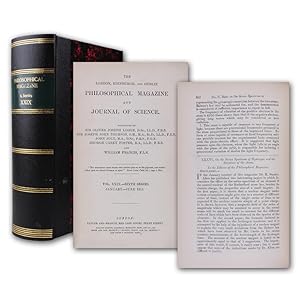
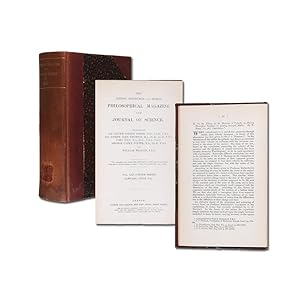
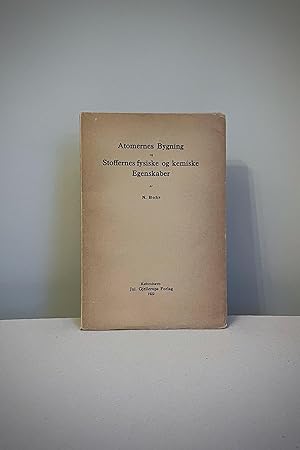
![Bild des Verkäufers für Determination of the Surface-Tension of Water by the Method of Jet Vibration. [Offprint from: Philosophical Transactions of the Royal Society of London, Series A, Vol. 209. pp. 281-317.] - [BOHR'S FIRST PUBLISHED PAPER - PRESENTATION COPY] zum Verkauf von Lynge & Søn ILAB-ABF](https://pictures.abebooks.com/inventory/md/md22791448194.jpg)
![Bild des Verkäufers für On the Theory of the Decrease of Velocity of Moving Electrified Particles on passing through Matter. [Off-print From the Philosophical Magazine (Vol. 25, No. 145) for January 1913 ]. - [THE FOUNDATION OF BOHR'S ATOMIC THEORY - PRESENTATION-COPY] zum Verkauf von Lynge & Søn ILAB-ABF](https://pictures.abebooks.com/inventory/md/md7030248871.jpg)

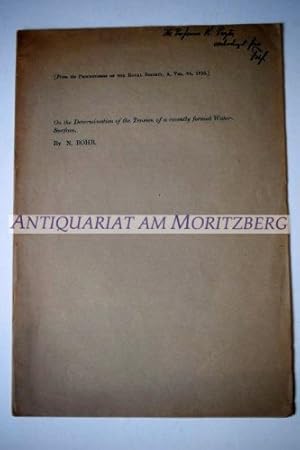
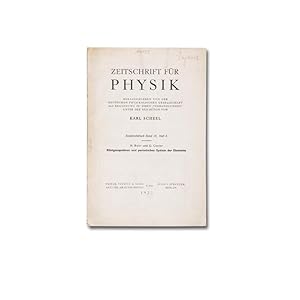
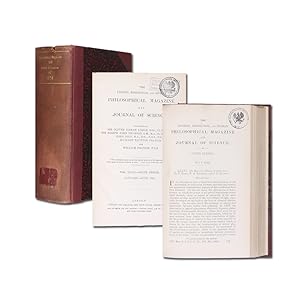
![Bild des Verkäufers für The mechanism of nuclear fission [N. Bohr. & J. A. Wheeler] "On continued gravitational contraction" [J. R. Oppenheimer & H. Snyder]. - [THE FIRST THEORETICAL DESCRIPTION OF A SINGULARITY] zum Verkauf von Lynge & Søn ILAB-ABF](https://pictures.abebooks.com/inventory/md/md22419195350.jpg)
![Bild des Verkäufers für Forces in molecules [Feynman] (+) The mechanism of nuclear fission [N. Bohr. & J. A. Wheeler] "On continued gravitational contraction" [J. R. Oppenheimer & H. Snyder]. - [FEYNMAN'S UNDERGRADUATE THESIS & THE FIRST THEORETICAL DESCRIPTION OF A SINGULARITY] zum Verkauf von Lynge & Søn ILAB-ABF](https://pictures.abebooks.com/inventory/md/md7979931078.jpg)

